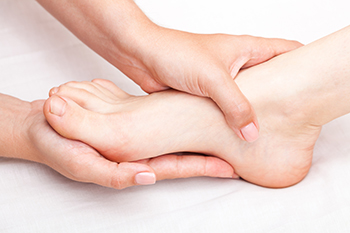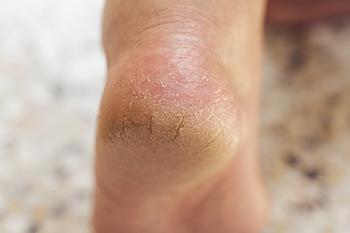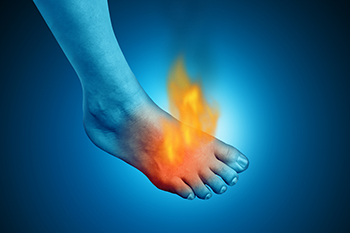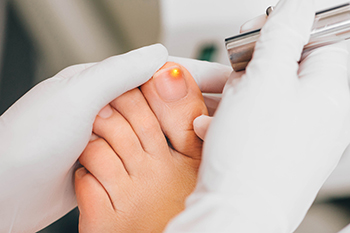
Connellsville


Plantar fibromatosis is a relatively rare, but often painful, condition that affects the plantar fascia, the thick band of tissue running along the bottom of the foot. Unlike more common foot problems, such as bunions or heel spurs, plantar fibromatosis is marked by the development of fibrous nodules or lumps within the plantar fascia. These nodules can vary in size and are typically firm to the touch. They often form in the arch of the foot but can appear in other areas as well. While the exact cause of plantar fibromatosis remains unclear, it's thought to be related to genetic factors and may also be influenced by trauma or injury to the foot. The condition is typically benign but can be quite painful, affecting one's ability to walk and engage in regular activities. Understanding plantar fibromatosis is important for early diagnosis and appropriate care, as it can help individuals find relief from this challenging foot condition. If you have developed this ailment, it is suggested that you confer with a podiatrist who can confirm the diagnosis and offer appropriate relief and treatment methods.
A plantar fibroma may disrupt your daily activities. If you have any concerns, contact Dr. Arnold Tarpley, Jr. of Tarpley Foot and Ankle Center. Dr. Tarpley can provide the care you need to keep you pain-free and on your feet.
Plantar Fibroma
A plantar fibroma is a fibrous knot in the arch of the foot. It is embedded in the plantar fascia which is a band of tissue that extends from the heel to the toes along the bottom of the foot. There can be multiple plantar fibromas in the feet at the same time. There are no known causes for this condition. If you have a plantar fibroma, there will be a bump in the arch of your foot that cannot be missed. Any associated pain is most often due to a shoe rubbing against the nodule. Non-surgical options, such as steroid injections, physical therapy, and orthotics should be tried first. Surgery is a last resort and is the only thing that will remove a plantar fibroma entirely. Consult with a podiatrist for a proper diagnosis and to determine the treatment regimen that is right for you.
What Causes a Plantar Fibroma?
While there are no specific causes identified, a plantar fibroma can possibly come from genetic predisposition or the formation of scar tissue that forms from healing the tears in the plantar fascia.
What Are the Symptoms of a Plantar Fibroma?
There will be a noticeable lump in the arch of the foot that may or may not cause pain. If pain is felt, it is typically because a shoe is rubbing up against the lump or when walking or standing barefoot.
Treatment and Prevention
A plantar fibroma will not disappear without treatment, but it can get smaller and be a non-issue. If pain persists, a podiatrist examines the foot and when the arch of the foot is pressed, pain can be felt down to the toes. An MRI or biopsy might be performed to help diagnose or evaluate the plantar fibroma. The following non-surgical options are generally enough to reduce the size and pain of these nodules:
Surgery is considered if the mass increases in size and the patient continues to feel pain after non-surgical methods are tried.
If you have any questions please feel free to contact one of our offices located in Uniontown, and Connellsville, PA . We offer the newest diagnostic tools and technology to treat your foot and ankle needs.

Heel fissures, which are cracks in the skin on your heels, can be more than just a cosmetic concern. Heel fissures often lead to discomfort and may even pose a risk of painful infections and skin damage. Diabetics are particularly susceptible to heel fissures because of the effects of damaged nerves in the feet that hinder natural moisturization. Dry skin is the most common cause associated with heel fissures, but various factors may contribute to their formation. Among them are eczema, athlete's foot, and environmental conditions. Additionally, medical conditions such as hypothyroidism, psoriasis, and rheumatoid arthritis can be factors. Any condition that results in the thickening of tissue or affects sweat production can heighten the risk. To tackle heel fissures, consider applying thick moisturizers twice a day. For more stubborn cases, a podiatrist may prescribe the use of products containing alpha hydroxy acids, salicylic acids, or urea to help shed dead skin cells. Anyone with heel fissures is wise to take this condition seriously. For help, it is suggested that you make an appointment with a podiatrist for an exam and appropriate treatment options.
If the skin on your feet starts to crack, you may want to see a podiatrist to find treatment. If you have any concerns, contact Dr. Arnold Tarpley, Jr. from Tarpley Foot and Ankle Center. Dr. Tarpley can provide the care you need to keep you pain-free and on your feet.
Cracked Heels
It is important to moisturize your cracked heels in order to prevent pain, bleeding, and infection. The reason cracked heels form is because the skin on the foot is too dry to support the immense pressure placed on them. When the foot expands, the dry skin on the foot begins to split.
Ways to Help Heal Them
Ways to Prevent Cracked Heels
If you are unsure how to proceed in treating cracked heels, seek guidance from a podiatrist. Your doctor will help you with any questions or information you may need.
If you have any questions, please feel free to contact one of our offices located in Uniontown, and Connellsville, PA . We offer the newest diagnostic and treatment technologies for all your foot care needs.

If you have ever experienced the uncomfortable sensation of burning feet after a run, you know how it can quickly put a damper on your exercise routine. The good news is that there are both immediate treatment options and preventive measures you can take to keep your feet cool and comfortable during and after your runs. Take a break after running and elevate your feet to reduce swelling and ease discomfort. Suggestions for preventing burning feet after running include selecting the right pair of shoes. Ensure they fit well, provide adequate arch support, and are designed for your specific activity. Keep your feet dry with moisture-wicking socks designed to pull sweat away from your skin. These socks are especially useful in hot weather or during intense exercise. Stretching your feet and legs before exercise can improve circulation and prevent burning sensations. If you continue to experience burning feet after running, it is suggested that you make an appointment with a podiatrist for helpful treatment and prevention tips.
Foot Pain
Foot pain can be extremely painful and debilitating. If you have a foot pain, consult with Dr. Arnold Tarpley, Jr. from Tarpley Foot and Ankle Center. Dr. Tarpley will assess your condition and provide you with quality foot and ankle treatment.
Causes
Foot pain is a very broad condition that could be caused by one or more ailments. The most common include:
Diagnosis
To figure out the cause of foot pain, podiatrists utilize several different methods. This can range from simple visual inspections and sensation tests to X-rays and MRI scans. Prior medical history, family medical history, and any recent physical traumatic events will all be taken into consideration for a proper diagnosis.
Treatment
Treatment depends upon the cause of the foot pain. Whether it is resting, staying off the foot, or having surgery; podiatrists have a number of treatment options available for foot pain.
If you have any questions, please feel free to contact one of our offices located in Uniontown, and Connellsville, PA . We offer the newest diagnostic and treatment technologies for all your foot care needs.

Corns on the feet can be a painful and frustrating problem. These small, hardened areas of skin can develop on the toes or bottom of the feet from friction or pressure. One cause of corns is wearing tight or improperly-fitted shoes, which can create constant friction on specific areas of the feet, leading to the formation of these painful skin growths. Also, individuals with foot deformities, such as bunions or hammertoes, may be more susceptible to developing corns. Frequent wearing of high heels, which shifts body weight toward the front of the foot and increases pressure on the toes, often results in corn development. Athletes or those engaged in activities that repeatedly stress the feet are also at a higher risk. Treatment of corns includes wearing comfortable, well-fitted shoes, using cushioned pads to alleviate pressure, and considering custom-made orthotic insoles to correct foot alignment. If a corn persists and causes discomfort, it is suggested that you make an appointment with a podiatrist. This foot doctor can safely remove a problematic corn and evaluate your feet to determine if custom orthotics may be needed in the future.
Corns can make walking very painful and should be treated immediately. If you have questions regarding your feet and ankles, contact Dr. Arnold Tarpley, Jr. of Tarpley Foot and Ankle Center. Dr. Tarpley will treat your foot and ankle needs.
Corns: What Are They? And How Do You Get Rid of Them?
Corns are thickened areas on the skin that can become painful. They are caused by excessive pressure and friction on the skin. Corns press into the deeper layers of the skin and are usually round in shape.
Ways to Prevent Corns
There are many ways to get rid of painful corns such as:
Treating Corns
Although most corns slowly disappear when the friction or pressure stops, this isn’t always the case. Consult with your podiatrist to determine the best treatment option for your case of corns.
If you have any questions please feel free to contact one of our offices located in Uniontown, and Connellsville, PA . We offer the newest diagnostic and treatment technologies for all your foot and ankle needs.

Laser therapy for fungal nails is an innovative treatment approach gaining popularity in the realm of podiatry. This non-invasive procedure harnesses the power of laser light to target and eliminate the fungal infection affecting the toenails. The laser's heat destroys the fungal cells while leaving the surrounding healthy tissue unharmed. This treatment is often preferred over oral antifungal medications as they can have side effects and may require prolonged use. One of the key advantages of laser therapy is its quick and virtually painless nature. Most patients require multiple sessions for optimal results, and there is typically no downtime after each session. Although laser therapy for fungal nails shows promise, it may not be effective for all cases, and results can vary from person to person. Ultimately, the goal is to restore healthy, clear nails and enhance overall foot health. If you have developed toenail fungus, it is strongly suggested that you contact a podiatrist who can determine if laser therapy is the correct treatment method for you.
Laser treatment can be an effective way to get rid of toenail fungus. If you have any questions about laser treatment, consult with Dr. Arnold Tarpley, Jr. from Tarpley Foot and Ankle Center. Dr. Tarpley will assess your condition and provide you with quality treatment for fungal nails.
What Are Toenail Fungal Infections?
Onychomycosis, or fungal infection of the nail, is a relatively common and non-serious condition. Around 10 percent of U.S. citizens are afflicted with fungal nails. Common forms of fungus that infect the nail include dermatophytes, yeasts, and molds.
Symptoms of Toenail Fungal Infections Include:
Diagnosis for Fungal Nails
Fungal infections are diagnosed by fungal culture and microscopy. This will rule out any other conditions such as nail trauma, psoriasis, lichen planus, and onychogryphosis.
What Is Laser Treatment?
Laser treatment is a non-invasive, safe, quick, and painless procedure that uses the heat from a laser to kill fungus in the nail. Each infected nail is targeted with a laser for several minutes. The treatment is usually utilized several different times over a select period. During this time, a podiatrist will keep an eye on the infection.
If you have any questions, please feel free to contact one of our offices located in Uniontown, and Connellsville, PA . We offer the newest diagnostic and treatment technologies for all your foot care needs.